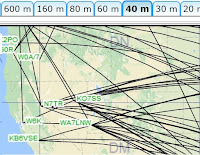During the month of August, our sun has been very busy, despite demonstrating very little sunspot activity.
The few sunspots left in Solar Cycle 24 have evidently been enough to cause some major disruptions in earth's geo-magnetic field throughout the month.
BOTH NAQP events & WAE Cw GiG suffered greatly due to K-Indices of 4, 5 & 6; along with A-Indices over 30 & 40.
I wrote a BLOG about the SEQP
event. [CLICK HERE] to read that entry.
I am used to solar storms during peak sunspot periods; encountering so many events during the bottom of the sunspot cycle has been an unfortunate surprise. While Monday's solar eclipse was known about for years, at least theoretically, there was no correlation between the Eclipse event
and the solar flare which occurred 4 days prior. They were unrelated events; or so it would seem.
Nevertheless, the Solar Eclipse QSO Party (SEQP) was conceived to investigate the possibility
that a solar eclipse could have an effect on HF radio communications; can you say "acute, geo-centered atmospheric cooling"?
In order to make things easier to track,
I registered the W6K 1x1 callsign for
use during the International Lighthouse event (Friday thru Sunday), the NAQP SSB contest on Saturday, and finally
the SEQP GiG on Monday.
It is well known that animals have experience a noticeable reaction to eclipse activity, however it is mainly based on the sudden appearance of what seems to them to be nightfall.
That the nightfall comes and goes so quickly may create a startle reaction that quickly dissipates into the memory jumble of the past. Because RF & light are all part of the electromagnetic spectrum, as the amount of light to reach a specific area of the planet diminishes significantly it is theorized that
we should experience something along the line of a brief "greyline" event.
Although I was on the radio nearly an hour before the eclipse period on the west coast, I can't say with any degree of certainty that there was any form of propagation improvement, in any particular direction. I remember hearing KH6 Hawaii on 20, but in fact never worked any area further due-west of California except north to Alaska.
Because this was a portable setup, I made use of the existing CH-250 vertical and put up a Cobra horizontal VEE with the arrowhead pointing exactly north. The ends of the Cobra antenna were
secured on the roof of the QTH. While the antenna was barely 7mh at its apex, the performance
was reasonable and usually more QRN quiet (compared to the CH-250).
Using the WQ6X antenna switch coupled with the Yaesu FT-1000mp's
built-in A/B antenna switching, either antenna could be run alone or the two could be run parallel, accepting whatever weird radiation pattern one could expect from such a combination.
Theoretically, paralleling the two antennas should've resulted in a line impedance of approx. 26 ohms; a value easily matched with the 1000mp's built-in antenna tuner.
 |
| Horizontal VEE + CH-250 |
 |
| Horizontal VEE only |
One of the goals for this SEQP was to call CQ using JUST the Horizontal VEE followed by CQ with BOTH the CH-250 Vertical and the Horizontal VEE paralleled together. As you can see, adding the vertical to the signal path opened up the number of directions my signal went; altho there was no indication of whether the original paths were strengthened or weakened by the use of both
antennas simultaneously.
 |
| Horizontal VEE w/CH-250 in middle |
While self-spotting is not normally allowed in most
radiosport events, for SEQP, honest self-spotting
added to the signal detection made by the CW
skimmer receivers around the world.
Self-spots plus the RBN (Reverse Beacon Network)
spotting data together can later be evaluated by the
analysis software "behind" the SEQP event.
Sorting out all this information should make for some interesting raw statistical data to evaluate.
Hopefully, a few months hence some sort of data analysis reports will be made available to us all regarding signal effects (if any) that may have been induced by the 90
minute long solar eclipse event as it made its way
across the United States.
Normally in contest events we endeavor to work
as many states, countries or zones as possible.
Because this event was more for research,
it made sense that we examine signal paths
on a much different basis. Using the VHF/UHF
grid square breakdown made more sense.
On that basis, the W6K operation worked a total of 33 grid squares around the U.S., as well as Alaska.
Did you work the SEQP event and submit
a Cabrillo log file afterwards?
Is one of W6K's 41 QSOs in YOUR Log?





No comments:
Post a Comment